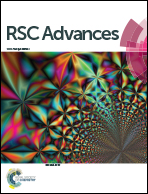Co2O3/Co2N0.67 nanoparticles encased in honeycomb-like N, P, O-codoped carbon framework derived from corncob as efficient ORR electrocatalysts†
Abstract
It is essential to develop cost-effective rechargeable metal–air batteries, with high activity, stability, and efficiency, that use non-precious metals (NPMs)-based cathodic oxygen reduction reaction (ORR) catalysts. Here, by using earth-abundant corncob (CC) as the carbon source, Co(OH)2, NaH2PO4, and melamine as the precursors, and KOH as the chemical activator, CoNP@bio-C-a is obtained and comparative studies are carried out with three other types of CC-derived carbon-based catalytic materials, namely, bio-C, CoP@bio-C, and CoNP@bio-C. Depending mainly on the formation of Co2O3/Co2N0.67 active sites (as p–n heterojunctions) and N, P, O-containing functional groups, the resultant CoNP@bio-C-a catalyst exhibits best electrocatalytic activity among the four types of catalysts; via a 4-electron pathway, it has good stability and good methanol tolerance. In addition, its unique honeycomb-like porous structure, high graphitization degree, and abundant oxygen-containing groups contribute to its excellent ORR activity. This study provides insights for exploring the application of heteroatom-doped biomass-derived carbon catalysts.



 Please wait while we load your content...
Please wait while we load your content...